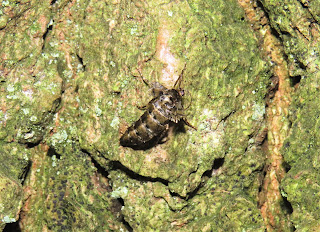It was during the Winter of last year, when the Moth front was quiet that I planned for this over-nighter to the South-west, with a few target species in mind. A few species that I have no choice but to leave Norfolk to enjoy.
On the hitlist were:
1) Thrift Clearwing - one of three Clearwings I still need to see.
2) High-brown Fritillary - a Butterfly I THINK we may have seen in North Devon, some years ago but not 100% so a confirmed view the aim.
3) Large Blue - another Butterfly restricted to just a few small areas in the UK.
Friday night I hit the hay at 2230 for a whole 90mins kip before the alarm went off at midnight to kick this mission off. On the road by 0100 to avoid the heat and traffic of the weekend coastal roads, I breezed through all the way to Hants where I picked up my good friend and regular comrade on such jaunts,
Richard Seargent. The very early start payed off and we were on the coast in Devon in good time, to our first stop for target #1 at Berry Head.
It didn't look good from the start with very little Thrift about and that which was there, definitely way past its best. With no shows to the pheromone lure at all, we headed back to the car with tails starting to fall back between our legs, in hope of more luck at another site in Prawle.
The walk from the car park along the coast was a hot one with the hedgerows buzzing with life and Cirl Buntings providing entertainment along the way.
Again, we found almost all the Thrift to be passed it and first attempts with the lure drew a blank, but just a matter of 20yds further along the path and BINGO! Before I had a chance to get a photo of the lone Thrift Clearwing, there were 3 working they way through the low growing plants, homing in on the pheromone. After grabbing a few pics, there were half a dozen in total and I stowed the lure away to avoid any more coming in. Success, and what a relief!
Target #1 by around midday, we hit the road again and headed for Dartmoor to look for the High-brown Fritillaries. On arrival, there wasn't a lot of activity and the increasing cloud cover was keeping things down low and more sheltered so on the down side, they would prove to be harder to spot but as the optimist, that also meant that any we found would likely be giving still views.
The odd Fritillary was stilled popping up and darting across the Bracken before disappearing swiftly into the undergrowth. Before getting even half way round the route we agreed on, we diverted into a small opening and were unbelievably lucky to have a big Orange Butterfly shoot in from nowhere and land on a small Bramble bush within 10-12ft of us. We froze. Anxious to raise our bins for a closer inspection but worried to not scare it off, we saw what we were hoping for, a line of brown bordered pearls (or ocelli) on the hindwing and a brief top view as its wings opened before darting off over the Bracken once again.
Cracking, close-up views but definitely no time to get the camera out for any shots this time.
With the heat, unrelenting humidity and early start beginning to slow us down a bit, it was back in the car to get to our accommodation for the night, but not before a short walk along the River Dart to enjoy views of a juvenile Dipper and Grey Wagtail.
We shared a spacious room with stunning views and relaxed for a while..
 |
| just resting my eyes... |
The temperature soon dropped and the wind didn't let up but it was a good nights sleep and we were ready to head back East via Somerset in hope of another rare Butterfly, the Large Blue.
Met on site by the same conditions as the previous days Butterfly hunt, the same rules applied - not easy to spot but if we did, the views would be good. A meander through the Somerset site was proving to be fruitless and I was starting to feel like the hat-trick might not happen until a lone Blue Butterfly got up between me and Rich and settled a short distance away - Large Blue!
A sigh of relief and whether it had seen better days or not, we enjoyed close views of the confiding individual, which would end up being the only one we see. Chuffed!
You can put yourself in the right place at the right time but there's never a guarantee with Nature so coming away with the 100% success rate on this occasion, made the 750+ mile round trip that much more tolerable.
Cheers Rich, for joining me. Big thanks also to
John Walters for the pointers.




















































